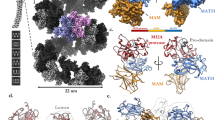Abstract.
The pancreas secretes primarily two types of metabolically important proteins: digestive enzymes and hormones. Lithostathine (LIT) is the only protein excreted from the pancreas that has no known digestive or hormonal activity. Human lithostathine is a 144-amino acid glycoprotein synthesized by the exocrine pancreas that has been implicated in various physiological functions, including inhibition of pancreatic stone formation. To better understand the physiological function of LIT, we expressed the recombinant LIT protein in Escherichia coli and measured its calcium binding properties by equilibrium dialysis and electron paramagnetic resonance (EPR) spectroscopy. Equilibrium dialysis with 45Ca2+ showed that LIT binds Ca2+ with 1:1 stoichiometry. EPR studies using the divalent vanadyl (VO2+) ion as a paramagnetic substitute for Ca2+ also showed that VO2+ binds to LIT with a metal:protein binding stoichiometry of 1:1 and that VO2+ competes with Ca2+ in binding to LIT. Mutations of a cluster of acidic residues on the molecular surface (E30A, D31A, E33A, D37A, D72A, and D73A) resulted in almost complete loss (95–100%) of binding of Ca2+ and VO2+, showing that these residues are critical for calcium binding by LIT.
Similar content being viewed by others
Author information
Authors and Affiliations
Additional information
Electronic Publication
Rights and permissions
About this article
Cite this article
Lee, BI., Mustafi, D., Cho, W. et al. Characterization of calcium binding properties of lithostathine. J Biol Inorg Chem 8, 341–347 (2003). https://doi.org/10.1007/s00775-002-0421-8
Received:
Accepted:
Issue Date:
DOI: https://doi.org/10.1007/s00775-002-0421-8




